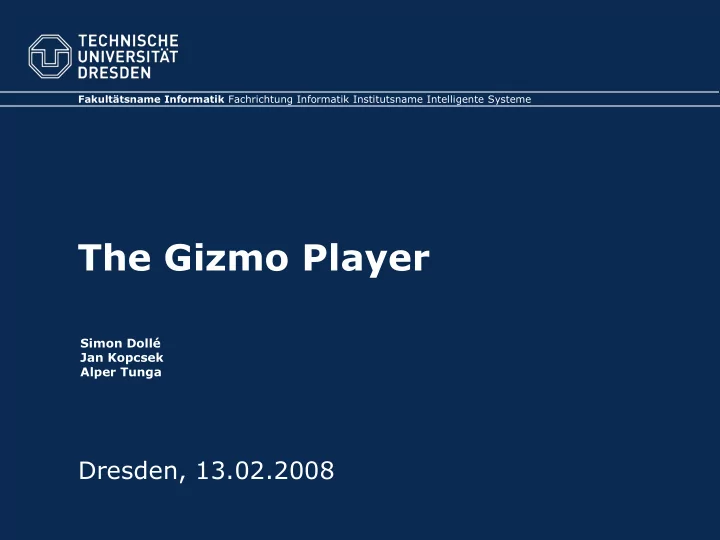

Fakultätsname Informatik Fachrichtung Informatik Institutsname Intelligente Systeme The Gizmo Player Simon Dollé Jan Kopcsek Alper Tunga Dresden, 13.02.2008
Finding a heuristic function Two ways for learning a heuristic function: • Deductive – Analyzing the rules – Identify common elements like game boards or pieces – Finding patterns • Inductive – Playing and learning from experience – Monte Carlo strategy TU Dresden, 13.02.2008 Gizmo Player Slide 2 of 10
Monte Carlo Strategy • Play random games • Compute the means of scores for each move Use them as a heuristic function TU Dresden, 13.02.2008 Gizmo Player Slide 3 of 10
Monte Carlo Strategy • Play random games • Compute the means of scores for each move Use them as a heuristic function TU Dresden, 13.02.2008 Gizmo Player Slide 3 of 10
Monte Carlo Strategy • Play random games • Compute the means of scores for each move Use them as a heuristic function TU Dresden, 13.02.2008 Gizmo Player Slide 3 of 10
Monte Carlo Strategy • Play random games • Compute the means of scores for each move Use them as a heuristic function TU Dresden, 13.02.2008 Gizmo Player Slide 3 of 10
Monte Carlo Strategy • Play random games • Compute the means of scores for each move Use them as a heuristic function TU Dresden, 13.02.2008 Gizmo Player Slide 3 of 10
Monte Carlo Strategy • Problem: Same effort spend on interesting moves and uninteresting moves • Equivalent to play against a dummy player • • UCT Algorithm (Upper Confidence Bound for Trees): An algorithm to balance: • Exploration of interesting parts of the graph Exploration of new parts Make random games more realistic • TU Dresden, 13.02.2008 Gizmo Player Slide 4 of 10
UCT Algorithm As long as there are unexplored • moves from our current state, explore them TU Dresden, 13.02.2008 Gizmo Player Slide 5 of 10
UCT Algorithm As long as there are unexplored • moves from our current state, explore them TU Dresden, 13.02.2008 Gizmo Player Slide 5 of 10
UCT Algorithm As long as there are unexplored • moves from our current state, explore them TU Dresden, 13.02.2008 Gizmo Player Slide 5 of 10
UCT Algorithm As long as there are unexplored • moves from our current state, explore them TU Dresden, 13.02.2008 Gizmo Player Slide 5 of 10
UCT Algorithm As long as there are unexplored • moves from our current state, explore them TU Dresden, 13.02.2008 Gizmo Player Slide 5 of 10
UCT Algorithm As long as there are unexplored • moves from our current state, explore them TU Dresden, 13.02.2008 Gizmo Player Slide 5 of 10
UCT Algorithm As long as there are unexplored • moves from our current state, explore them Otherwise, choose the one with • the highest score using h : the heuristic value n : the number of games through the parent node n i : the number of games through the node TU Dresden, 13.02.2008 Gizmo Player Slide 6 of 10
UCT Algorithm As long as there are unexplored • moves from our current state, explore them Otherwise, choose the one with • the highest score using h : the heuristic value n : the number of games through the parent node n i : the number of games through the node TU Dresden, 13.02.2008 Gizmo Player Slide 6 of 10
UCT Algorithm As long as there are unexplored • moves from our current state, explore them Otherwise, choose the one with • the highest score using h : the heuristic value n : the number of games through the parent node n i : the number of games through the node TU Dresden, 13.02.2008 Gizmo Player Slide 6 of 10
UCT Algorithm As long as there are unexplored • moves from our current state, explore them Otherwise, choose the one with • the highest score using h : the heuristic value n : the number of games through the parent node n i : the number of games through the node TU Dresden, 13.02.2008 Gizmo Player Slide 6 of 10
UCT Algorithm As long as there are unexplored • moves from our current state, explore them Otherwise, choose the one with • the highest score using h : the heuristic value n : the number of games through the parent node n i : the number of games through the node TU Dresden, 13.02.2008 Gizmo Player Slide 6 of 10
UCT Algorithm Which move to play? • The one with the highest heuristic value In multiplayer games: • Store the heuristic value for each player TU Dresden, 13.02.2008 Gizmo Player Slide 7 of 10
Good points • Heuristic directly linked to the final score • Heuristic converges to min-max values • Time scalable • Easily parallelisable TU Dresden, 13.02.2008 Gizmo Player Slide 8 of 10
Problems • Simultaneous moves: – What rule to choose to explore the nodes? – Which move to play? • Long games and loops: – Depth first search problem TU Dresden, 13.02.2008 Gizmo Player Slide 9 of 10
Thank you for your attention And good luck to your players TU Dresden, 13.02.2008 Gizmo Player Slide 10 of 10
Recommend
More recommend